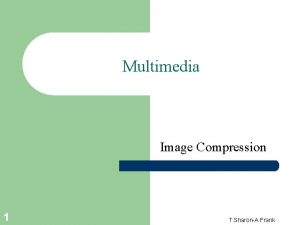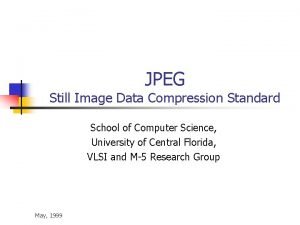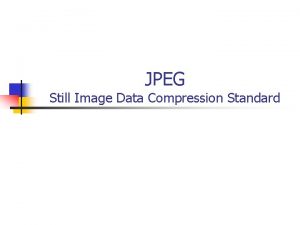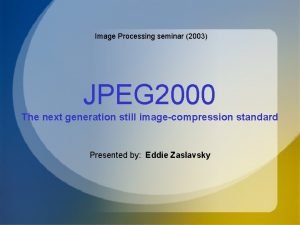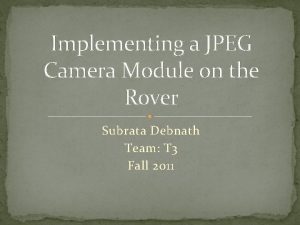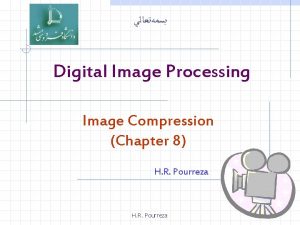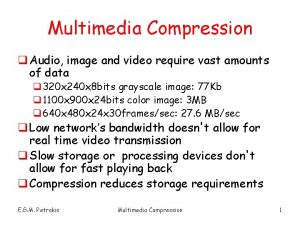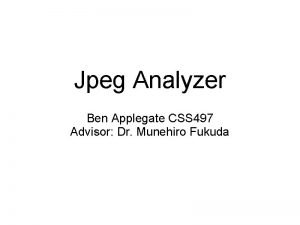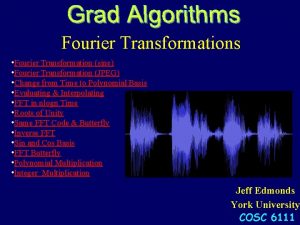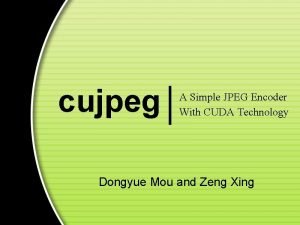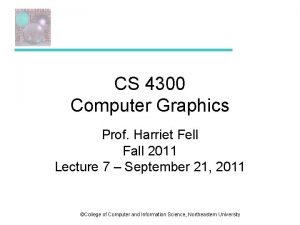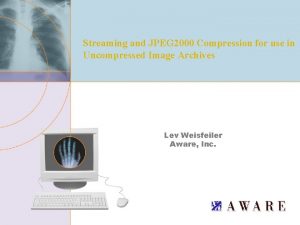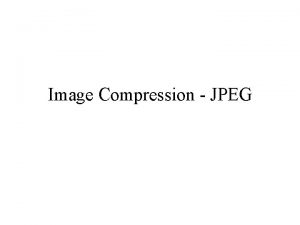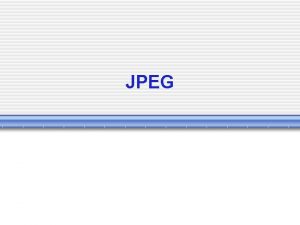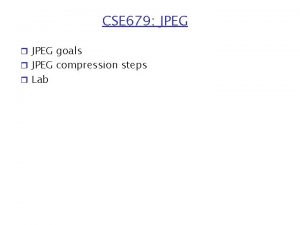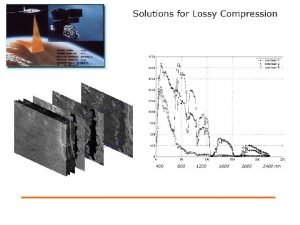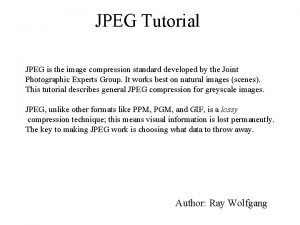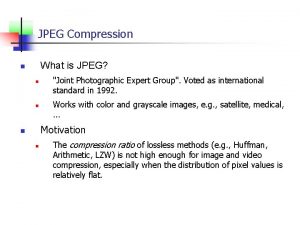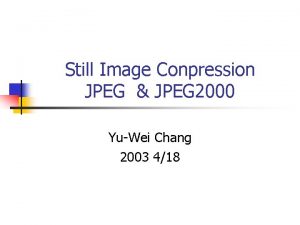Streaming and JPEG 2000 Compression for use in












- Slides: 12

Streaming and JPEG 2000 Compression for use in Uncompressed Image Archives Lev Weisfeiler Aware, Inc.

Archives of Uncompressed Images § Data stored uncompressed in PACS § 2000 x 2500 CR – Total Image size: 10 MB § 512 x 512 CT – Total Image size: 0. 5 MB § Great for fast networks since no time spent on decoding § Lossless data quality

Viewing Images over Slower Networks § User connecting over slower link may prefer compressed data, to minimize time to display of full fidelity images § Total time to display = compression time on server transmission time decompression time on client + +

Streaming of Compressed Data § The total time can be reduced if any of these processes can be done in parallel § Streaming: decompression and transmission can be interleaved – data is decompressed and displayed progressively, as it is received, without waiting for full image data § Compression and transmission can be interleaved as well

JPEG Streaming § JPEG encodes data in blocks of 8 x 8 pixels; § Blocks can be transmitted as they are encoded, without waiting for the rest of the data. – Precludes the use of the progressive mode of JPEG • In progressive mode, the DC terms from each block are grouped at the front – Image can be progressively decoded in 8 row chunks, essentially appearing line-by-line from top to bottom. § A significant proportion of the image data is necessary for a meaningful first view

JPEG 2000 Progressive Encoding § Progressive Encoding By Quality – Image is processed by the wavelet transform – First quality layer is produced by encoding some of the wavelet transform data; the layer is transmitted in a “tile part” • “tile part” is a JPEG 2000 codestream unit – Process repeated for production of next layer § Progressive Encoding By Resolution – Image is processed by the wavelet transform – The lowest resolution data is encoded and transmitted in a tile part – Process repeated for production of next resolution data

JPEG 2000 Progressive Encoding § Progressive Encoding By Color Channel – First color channel is processed by the wavelet transform, fully encoded, and transmitted in a tile part – Process repeated for production next channel § Progressive Encoding By Spatial Region – In a tiled image, each tile can be processed and transmitted independently – In an untiled image, precincts are defined for the image and are encoded in their proper order, with each one being transmitted once it is fully encoded • Precincts are a spatial division of the wavelet transform data

CR Example § Network: DSL 2 Mb/sec, 50% utilization, 10% overhead § 2500 x 2048 CR 10 MB Uncompressed – Transmit time ~ 90 seconds – Total time to display: 90 seconds § 2500 x 2048 CR Losslessly Compressed (4 MB) – Compression: 1. 77 sec – Decompression: 1. 44 sec – Transmit time ~35 seconds – Total Time to display: ~39 seconds

CR Example § 2500 x 2048 CR Losslessly Compressed with 3 Quality Layers – Thumbnail: 70 KB – Visually lossless (20: 1) : 540 KB – Lossless: 3. 4 MB § Progressive Encoding Time: – Layer 1: 0. 42 sec – Layer 2: 0. 41 sec – Layer 3: 1. 08 sec § Decompression Time: – Layer 1 only: 0. 14 sec – Layer 1 and 2: 0. 35 sec – All three layers: 1. 45 sec § Time to View: – Layer 1: (0. 42 sec + 0. 6 sec + 0. 14 sec) ~= 1. 2 seconds – Layer 1 and 2: (0. 41 sec+ 5 sec +0. 35 sec) ~= 6 seconds – All three layers: (1. 08 sec + 30 sec +1. 45 sec) ~= 33 seconds

CT Example § Network: DSL 2 Mb/sec, 50% utilization, 10% overhead § 512 x 512 CT 500 KB Uncompressed – Transmit time ~ 4. 5 seconds – Total time to display: 4. 5 seconds § 512 x 512 CT Lossless Compressed 1 layer: 130 KB – Compression: 0. 13 sec – Decompression: 0. 10 sec – Transmit time 1. 1 seconds – Total Time to display: 1. 33 seconds

CT Example § 512 x 512 CT Lossless Compressed 3 Layers – Thumbnail: 10 KB – Visually lossless (25: 1) : 20 KB – Lossless: 130 KB § Compression: – Layer 1: 0. 08 sec (encoding + x-form time) – Layer 2: 0. 02 sec (encoding only) – Layer 3: 0. 03 sec (encoding only) § Decompression: – Layer 1: 0. 05 sec – Layer 1+2: 0. 06 sec – Layer 1+2+3: 0. 10 sec § Time to View: – Layer 1: (0. 08 sec + 0. 09 sec + 0. 05 sec) ~= 0. 22 seconds – Layer 1+2: (0. 02 sec+ 0. 18 sec +0. 06 sec) ~= 0. 26 seconds – Layer 1+2+3: (0. 03 sec + 1. 17 sec +0. 10 sec) ~= 1. 3 seconds

Adaptable Process § JPEG 2000 encoding progressions can be mixed – E. g. : First resolution and then quality progression orders would have the lowest resolution data progressively encoded by quality and transmitted, followed by the next resolution § Granularity of the interleaving of the compression process and the transmission process can be adapted for: – time to first image display – time to full image display. § Optimized based on: – application needs – relative loads on the processor – network speed
 Block size in block preparation step of jpeg compression is
Block size in block preparation step of jpeg compression is What's wrong in the picture
What's wrong in the picture Jpeg: still image data compression standard
Jpeg: still image data compression standard Jpeg still image data compression standard
Jpeg still image data compression standard Jpeg 2000 compressor
Jpeg 2000 compressor Jpeg disadvantages
Jpeg disadvantages Fritzing camera
Fritzing camera Lossy compression in digital image processing
Lossy compression in digital image processing Mpeg vs jpeg
Mpeg vs jpeg Css analyzer
Css analyzer Jpeg fft
Jpeg fft Simple jpeg
Simple jpeg Jpeg to png
Jpeg to png
